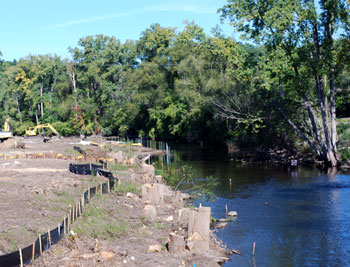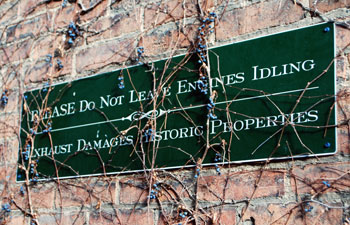Four entities – including the federal Environmental Protection Agency and the local Huron River Watershed Council – have filed letters of objection with the state of Michigan to a project that would add a recreational section of whitewater along the Huron River, next to the new Argo Cascades.

A view looking upstream at the Huron River from the Broadway Bridge, toward the section of the proposed whitewater feature. On the left is environmental remediation work on the DTE/MichCon property. (Photo by D. Askins.)
Colin Smith, Ann Arbor’s parks and recreation manager, informed the park advisory commissioners about the opposition at PAC’s Sept. 18, 2012 meeting, describing the news as “not especially positive.” Other letters filed against the project were from the state Dept. of Natural Resources fisheries division and the U.S. Fish & Wildlife Service.
The project requires a permit from the Michigan Dept. of Environmental Quality (MDEQ) because it affects the Huron River, a state waterway. The project was originally approved by the Ann Arbor city council in 2010, as part of a larger effort that included building the Argo Dam bypass, which wrapped up earlier this year. Subsequent to that council approval, DTE Energy offered to pay for and oversee the whitewater aspect, to coordinate it with environmental remediation work that’s taking place on property it owns along that stretch of the river, just downstream of Argo Dam.
DTE is the applicant for the whitewater permit, although the company is working closely with the city on the project. The city is interested in acquiring the DTE property along the Huron after remediation is completed – and it’s hoped that the company might gift it to the city as a park.
Smith told PAC members that the EPA objection – because it comes from a federal environmental oversight agency – has triggered a process that might stop the project. The EPA filed its letter on Aug. 15. From that date, the MDEQ has 90 days [until Nov. 13] to resolve the EPA’s concerns with the applicant.
The EPA’s letter from Tinka Hyde, director of the agency’s water division, states that the project could significantly degrade the Huron River by inhibiting fish passage and increasing the water velocity, which in turn could affect sediment flow and degrade the stability of that section of the river. Another concern cited is that the project could constrain public use of the river. Because of these issues, the EPA believes the project does not comply with the federal Clean Water Act. [.pdf of EPA letter]
Similar concerns were cited in the other letters of objection. Additional issues raised include water quality concerns that could affect the health of those using the whitewater area, who might come in contact with E.coli in the river; and exacerbated flow problems during drought periods. [U.S. Fish & Wildlife Services letter] [DNR fisheries division letter and additional attachments] [HRWC letter]
The DNR fisheries letter – signed by Jeffery Braunscheidel, senior fisheries biologist – also alludes to the contentious “dam in/dam out” debate involving Argo Dam. Structures used to create the whitewater are in essence dams, he stated, and the division does not support new dam construction. “Planning should provide for a naturally functioning system below Argo Dam as history has made clear that, at some point in time, the Argo Dam will be modified or removed. Impediments should not be constructed in the river that the public will again be asked to address.”
But it’s the EPA’s objection that carries the most weight. If the EPA does not withdraw its objection and the MDEQ still decides to grant the permit, then DTE would also need to seek a permit from the U.S. Army Corps of Engineers before the project can move forward. [Full Story]





